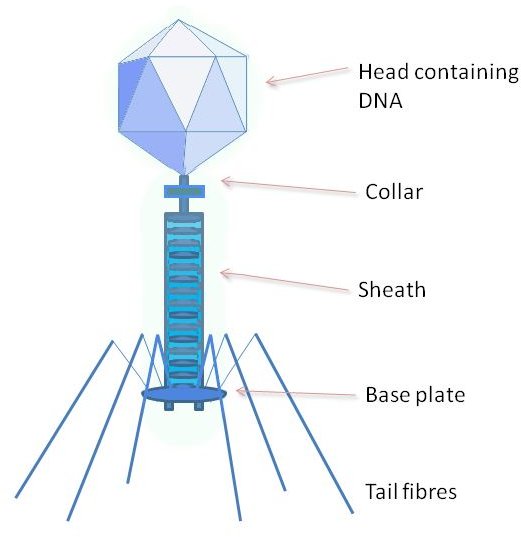A Study Guide to How Germs and Viruses Work in the Body
Better Wash Your Hands!
How many times has your mother told you to wash your hands when you got home? As much as you may want to skip that step, hand washing can help ward off germs! While you cannot see germs with the naked eye, they can make you sick.
Four types of germs exist, with one of them being viruses. It is considered a virus if it has
a) infectious particles,
b) a nuclei acid core of either RNA or DNA, and
c) a protective protein coat around the infectious nuclei acid.
A virus can cause illnesses such as the common cold, the flu and chickenpox. But viruses cannot survive on their own — they need living cells to replicate. This could be a human, animal, plant, even bacteria. One type of virus, a bacteriophage, can infect bacteria. But while viruses need a living organism to make more of themselves, they can survive for some time on an inanimate object — like the doorknob you just touched entering the house.
Infection vs. Disease
You may have heard the terms “infection” and “disease” in health class. While they may sound like the same thing, they differ on how the virus has affected the person’s body. An infection refers to viruses entering the body and replicating. When it is considered a disease, the viruses have destroyed some healthy cells in the body, and the symptoms of the illness begin. That is when you will see a person coughing, hopefully covering her mouth so that the virus does not spread to you. So how do viruses work in the body?
The life cycle of a virus once it has entered the body can be broken up into six steps. First is attachment in which the virus binds to the surface of the host cell. The virus has receptors and it can attach itself to the host cell if it can connect to the complementary receptors found on the cell membrane. Once the virus attaches itself to the cell membrane, it needs to get into the cycle to reproduce. That step is called penetration. The method of entry depends on the type of virus. For example, with a bacteriophage, the protective protein coat stays on the outside and the nuclei acid goes into the host cell. Some viruses may enter through a process called endocytosis, as shown by this diagram from Brooklyn College.
The next stage in a working virus is uncoating, in which the infectious nuclei acid gets released from its protective coat. With bacteriophages, penetration and uncoating happen at the same time. For other viruses, enzymes can break it down. Now that the infectious material from the virus is in the host cell, it starts replicating itself. This stage, synthesis, can be divided further into three parts: transcription, translation and genome replication. In transcription, a complementary strand of RNA is made for the virus’ DNA. During translation, that complementary RNA is turned into proteins by the host’s ribosomes, with the full copy of the virus’ genetic material completed in genome replication. Once all the parts are made, full viruses, like the one that infected the host cell, are created in assembly. After these replicated viruses are completed, they go through the last stage — release — in which they can go on to infect other healthy cells. The host cells in which the virus reproduces eventually get destroyed.
How Do Vaccines Help?
While some viruses cause illnesses such as the common cold which go away after some rest and medications, other illnesses caused by viruses are more severe, such as smallpox and polio. That is why we have vaccines, which teaches your body how to fight these infections by mimicking them. The vaccine contains a weaker version of the virus, which your body fights. Macrophages engulf the weakened virus, saving the virus’ antigens and bringing them to the lymph nodes. In the lymph nodes are two types of cells: T cells and B cells. The T cells eliminate infected cells while the B cells make antibodies. With the vaccine, the T and B cells clear up the infection quickly, and the memory T and B cells can protect the person from a future infection of the virus. So instead of that virus replicating and destroying healthy cells after entering the body, the immune system can nip the infection right in the bud.
Testing Your Knowledge

Can you identify the six steps of the virus’ life cycle when it enters the body? Do you know what happens in each step? Test out your knowledge of how viruses work in the body before that big test. Click on the picture of the virus’ life cycle and print out a copy. Below the image, write out numbers one through six, and label the six steps. Bonus points if you can remember the three parts of step four! Once you have those down, challenge yourself by writing a quick description of each step. After you have finished, check your answers. Did you get them all right?
References
- US Department of Health and Human Services: Understanding Vaccines: What They Are, How They Work, http://www.niaid.nih.gov/topics/vaccines/documents/undvacc.pdf
- KidsHealth.org: What are Germs?, http://kidshealth.org/PageManager.jsp?dn=KidsHealth&lic=1&ps=307&cat_id=124&article_set=10501
- Image: Phage by GrahamColm under CC by –SA 3.0
- Image: Virus Replication Cycle under CC by –SA 3.0
- MayoClinic.com: Germs: Understand and Protect Against Bacteria, Viruses and Infection, http://www.mayoclinic.com/health/germs/ID00002/METHOD=print
- University of Calgary: Virus Life Cycle, http://people.ucalgary.ca/~ceri/cmmb421prot/Virus%20Life%20Cycle.html
